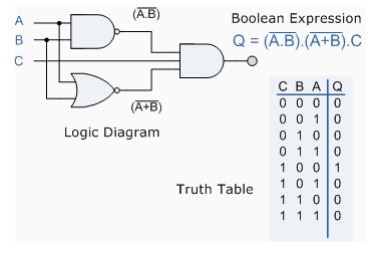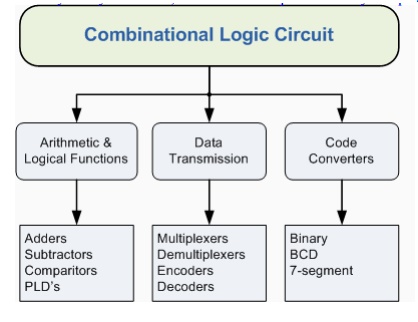Chapter: Basic Electrical and Electronics Engineering : Digital Electronics
Combinational Logic Circuits
Combinational Logic
Circuits
Unlike Sequential Logic Circuits whose outputs are
dependant on both their present inputs and their previous output state giving
them some form of Memory, the
outputs of Combinational Logic Circuits are
only determined by the logical
function of their current input state, logic "0" or logic
"1", at any given instant in time as they have no feedback, and any
changes to the signals being applied to their inputs will immediately have an
effect at the output. In other words, in a Combinational
Logic Circuit, the output is dependant at all times on the combination of
its inputs and if one of its inputs condition changes state so does the output
as combinational circuits have "no memory", "timing" or
"feedback loops".
Combinational Logic

Combination Logic
Circuits are made up from basic logic NAND, NOR or NOT gates that
are "combined" or connected together to produce more complicated
switching circuits. These logic gates are the building blocks of combinational
logic circuits. An example of a combinational circuit is a decoder, which
converts the binary code data present at its input into a number of different
output lines, one at a time producing an equivalent decimal code at its output.
Combinational logic circuits can be very simple or very complicated and any combinational circuit can be implemented with only NAND and NOR gates as these are classed as "universal" gates. The three main ways of specifying the function of a combinational logic circuit are:
Truth Table Truth tables provide a concise list that shows the output values in tabular form for each possible combination of input variables.
Boolean Algebra Forms an output expression for each input variable that represents a logic "1"
Logic Diagram Shows the wiring and connections of each individual logic gate that implements the circuit and all three are shown below.

As combination logic circuits are made up from individual logic
gates only, they can also be considered as "decision making circuits"
and combinational logic is about combining logic gates together to process two
or more signals in order to produce at least one output signal according to the
logical function of each logic gate. Common combinational circuits made up from
individual logic gates that carry out a desired application include Multiplexers, De-multiplexers, Encoders, Decoders, Full and Half Adders etc.
Classification of
Combinational Logic
One of the most common uses of combination logic is in
Multiplexer and De-multiplexer type circuits. Here, multiple inputs or outputs
are connected to a common signal line and logic gates are used to decode an
address to select a single data input or output switch. A multiplexer consist
of two separate components, a logic decoder and some solid state switches, but
before we can discuss multiplexers, decoders and de-multiplexers in more detail
we first need to understand how these devices use these "solid state
switches" in their design.

Related Topics